Article Information
VOLUME XI, NUMBER 191
EIGHT PAGES
Single Copy 15c
THURSDAY, MARCH 17, 197
Last year, the seriously-injured victim of a spectacular car wreck near Clark Fork lay waiting nearly an hour and a half for an ambulance to transport him to Bonner General Hospital.
Over the past two years, there have been six critical occasions when residents in the Clark Fork Valley needed an ambulance: three auto accidents, two heart attacks, and a case of several lacerations suffered by a camper. Each time, it took the emergency vehicle some 25 miles away anywhere from 35 minutes to an hour and twenty minutes just to reach the victims.
So thirteen concerned citizens of that area, plus the fire chief of nearby East Hope, decided to do something on their own to hasten the possibly-fatal delays.
They’ve since completed an 80 hour emergency medical training course and started their own ambulance service.
“It’s not the fault of the Sandpoint ambulance service that it takes so long to get out here,” explained Alan Gross, one of the Clark Fork attendants. “It’s just that when you have to drive close to 30 miles and back again to the hospital that a long wait has to be expected.”
Many of the thousand or so persons living in that area used to take a chance of driving to the hospital themselves in an emergency situation, rather than waiting for the ambulance to arrive.
But no more. The valley now has 14 qualified ambulance attendants, and sports a 1971 ambulance bought recently from the Newport, Wa., ambulance service. The used vehicle, complete with a life support system, was purchased by a private party at a bargain price of $1,650.
Originally, the citizens had offers for federal and state grants to buy a new modular van with four-wheel drive and worth nearly $7,000 even without emergency treatment equipment. “But the insurance would have cost us over $3,000 a year alone,” said Gross. “And they couldn’t guarantee delivery of the new van until September of this year.”
The group also has a 1951, four-wheel drive army ambulance, reminiscent of the M-A-S-H units so popular during the Korean War. “We plan to make it available to the Bonner County Search and Rescue team, if they want it,” said Albert Schenck, another attendant and mayor of Clark Fork.
The vehicle is best suited to the mountainous country surrounding Clark Fork, “and can be a real help if any of the numerous loggers in the area ever gets in trouble,” Schenck added. The old van will now house equipment for extracting persons trapped in automobiles.
The 14 attendants had to drive 25 miles to Sandpoint twice weekly to attend more than 80 hours of class instruction. Sponsored by the Idaho State Department of Health and Welfare. Each person also had to pay $25 to take the course, which was paid out of the ambulance fund. Teaching the course was Pat Grimes from the Coeur d’Alene ambulance service.
During that time, the class learned “just about everything a layman needs to know for any emergency that we’ll encounter within our area,” said Art Shively, one of the prime movers of the EMT program.
The 14 learned a variety of things, including: all about the different kinds of life support systems, monitoring of vital functions, bandaging and splinting, cardio-pulmonary resuscitation, unscheduled childbirth, drug abuse and poisons, burn care, and even radiation fallout first aid.
In addition, all members of the service traveled to Deaconess Hospital in Spokane for a ten-hour look at the life support systems in the hospital emergency room.
They also traveled to Post Falls one day, for an eight-hour course on extracting trapped persons from automobiles. That program was put on February 6 by the Post Falls Volunteer Fire and Ambulance Department. More than 100 persons from around the Northwest also attended the training seminar.
Those completing the entire ambulance attendant course were: Ambrose Martinosky, Raymond Taylor, Albert Schenck, Marie Statzel, Paula Kaplan, Alan and Jan Gross, Jim White, Art Shively, Gary Parsons, Anita Smith, Paul Gabriel, and Bob Rice.
“We all had a deep feeling this type of service was really needed for the area,” Shively said. “Everybody just jumped right in, and we’ve been real successful so far.”
The original idea of forming an ambulance service was introduced in the fall of 1974 by then-Clark Fork Mayor Emma Rathbun. Later that year, nine persons of the town went through a “quick response unit” training program.
The nine completed 40 hours of intense training, taken in what used to be the town jail. Five of the original nine also took this year’s ambulance attendant course.
The city of Clark Fork is currently in the process of turning the old jail over to the service as a small medical center. Barred doors and cement walls still remain in the structure.
To meet the cost of insurance, plus getting cash to pay for the newer ambulance and much-needed equipment, the service is sponsoring a benefit dinner beginning at 1:30 p.m. Sunday, March 20 at the Clark Fork School. The supper will feature a turkey dinner with all the trimmings.
Both ambulances will be on display, and the attendants will be giving demonstrations on cardio-pulmonary resuscitation and the Heimlech technique, a method for removing obstacles in a person’s throat.
Besides the benefit dinner, the group is also selling “shares” in the organization. For a $25 donation, the giver and any member of his family will be eligible for a free ride in the ambulance if the need ever comes up. Shively said the usual price for such a trip is $50.
“All we’re waiting on now is the insurance,” Shively said. “As soon as we get that, we’ll be ready to roll.”
